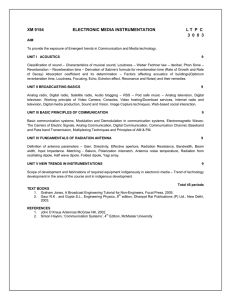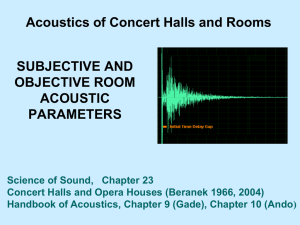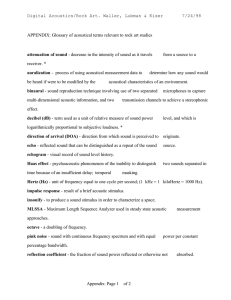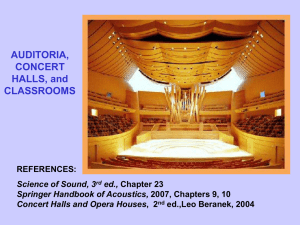Lecture Halls - Room Acoustics and Sound Reinforcement 1
advertisement
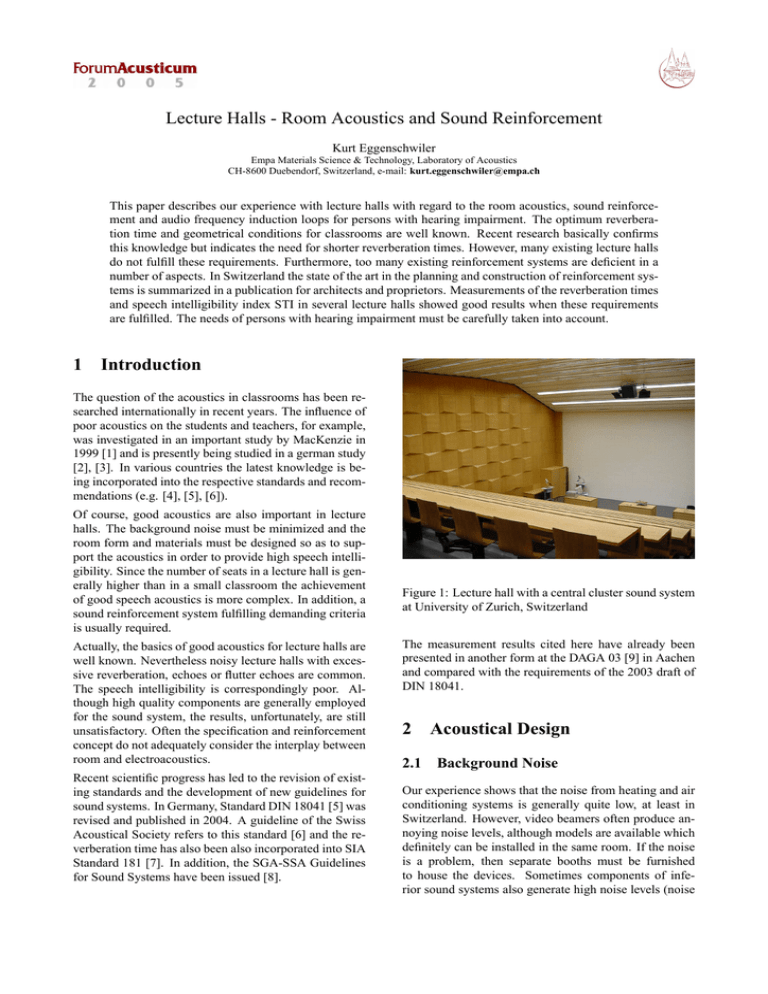
Lecture Halls - Room Acoustics and Sound Reinforcement Kurt Eggenschwiler Empa Materials Science & Technology, Laboratory of Acoustics CH-8600 Duebendorf, Switzerland, e-mail: kurt.eggenschwiler@empa.ch This paper describes our experience with lecture halls with regard to the room acoustics, sound reinforcement and audio frequency induction loops for persons with hearing impairment. The optimum reverberation time and geometrical conditions for classrooms are well known. Recent research basically confirms this knowledge but indicates the need for shorter reverberation times. However, many existing lecture halls do not fulfill these requirements. Furthermore, too many existing reinforcement systems are deficient in a number of aspects. In Switzerland the state of the art in the planning and construction of reinforcement systems is summarized in a publication for architects and proprietors. Measurements of the reverberation times and speech intelligibility index STI in several lecture halls showed good results when these requirements are fulfilled. The needs of persons with hearing impairment must be carefully taken into account. 1 Introduction The question of the acoustics in classrooms has been researched internationally in recent years. The influence of poor acoustics on the students and teachers, for example, was investigated in an important study by MacKenzie in 1999 [1] and is presently being studied in a german study [2], [3]. In various countries the latest knowledge is being incorporated into the respective standards and recommendations (e.g. [4], [5], [6]). Of course, good acoustics are also important in lecture halls. The background noise must be minimized and the room form and materials must be designed so as to support the acoustics in order to provide high speech intelligibility. Since the number of seats in a lecture hall is generally higher than in a small classroom the achievement of good speech acoustics is more complex. In addition, a sound reinforcement system fulfilling demanding criteria is usually required. Actually, the basics of good acoustics for lecture halls are well known. Nevertheless noisy lecture halls with excessive reverberation, echoes or flutter echoes are common. The speech intelligibility is correspondingly poor. Although high quality components are generally employed for the sound system, the results, unfortunately, are still unsatisfactory. Often the specification and reinforcement concept do not adequately consider the interplay between room and electroacoustics. Recent scientific progress has led to the revision of existing standards and the development of new guidelines for sound systems. In Germany, Standard DIN 18041 [5] was revised and published in 2004. A guideline of the Swiss Acoustical Society refers to this standard [6] and the reverberation time has also been also incorporated into SIA Standard 181 [7]. In addition, the SGA-SSA Guidelines for Sound Systems have been issued [8]. Figure 1: Lecture hall with a central cluster sound system at University of Zurich, Switzerland The measurement results cited here have already been presented in another form at the DAGA 03 [9] in Aachen and compared with the requirements of the 2003 draft of DIN 18041. 2 Acoustical Design 2.1 Background Noise Our experience shows that the noise from heating and air conditioning systems is generally quite low, at least in Switzerland. However, video beamers often produce annoying noise levels, although models are available which definitely can be installed in the same room. If the noise is a problem, then separate booths must be furnished to house the devices. Sometimes components of inferior sound systems also generate high noise levels (noise Forum Acusticum 2005 Budapest Eggenschwiler from fans as well as electronic noise such as hiss, hum or clicks). DIN 18041 [5] specifies three categories of noise limits, see Table 1. These are a function of distance between the talker and listeners, the makeup of the listeners and the type of instruction (for hearing impaired, difficult and foreign language texts). For lecture halls noise limits of 35 dB(A) or 30 dB(A) are recommended. Requirements low middle high 2.3 Room Form The well-known rules concerning room form remain valid. These principles are clearly presented and illustrated for architects in DIN 18041 [5] and in many technical books (for example [10]). Nevertheless, disturbing errors in the geometrical form occur repeatedly, resulting in echoes or flutter echoes (see figure 3) Maximum Noise Level 40 dB(A) 35 dB(A) 30 dB(A) Table 1: Maximum allowable background noise levels in accordance with DIN 18041 2.2 Reverberation Time reverberation timel [s] In the revised DIN 18041 [5] the recommended reverberation times are given according to the latest knowledge, see figure 2. For the unoccupied room the reverberation time should not exceed the recommended values by more than 0.2 seconds. 1.0 0.8 0.6 3 Sound System 0.4 0.2 3.1 Guidelines 0.0 10 100 1000 10000 room volume [m3] In Switzerland the Swiss Acoustical Society SGA-SSA has presented a recommendation for sound systems for architects and building contractors [8]. This is supplemented by guidelines for structures for hearing impaired persons [11]. DIN 18041 [5] now also gives requirements for sound systems. If the system is part of an evacuation system, the requirements of Standard EN 60849 apply [13]. 1.4 1.2 RT / RTo Figure 3: Rear wall of a lecture hall (not the same room as in figure 1), which throws an annoying echo back toward the front area, with or without the sound system. 1.0 0.8 0.6 0.4 10 100 1000 frequency [Hz] 10000 Figure 2: Optimum reverberation time for occupied instruction rooms for the octave bands 500 Hz and 1000 Hz (above) and band of tolerance for the recommended reverberation time as a function of frequency (below) according to DIN 18041. RTo = optimal reverberation time according to the upper diagramm, RT = reverberation time. 3.2 Speech Intelligibility The minimum requirements for lecture halls are given in [5] as a function of the room size and a testing method is described in [13]. (see [8] as well): Common Intelligibility Scale CIS Speech Transmission Index STI Definition Articulation Loss of Consonants ALcons ≥ 0.75 ≥ 0.56 ≥ 0 dB <8% Forum Acusticum 2005 Budapest 3.3 Sound Level In order to achieve the minimum values of speech intelligibility, it is obviously necessary to provide a sufficiently high sound level. No other requirements apply to the sound level. In situations without significant background noise the speech level should be at least 65 - 75 dB(A) at all the seats. Level differences in the seating area should not exceed 6 dB(A). 3.4 Localization and Tone Quality The correct localization of the sound source and a natural tone quality are not the main factors relating to speech intelligibility. However, they do add to the listener’s attentiveness and thus contribute to the speech intelligibility. To produce the correct localization the loudspeakers have to be provided with a suitable time delay. Although this increases the complexity of the electronics and amplifiers, the improvement is definitely worth the effort. Often the sound system produces an unnecessary and disturbing emphasis on the low frequencies. Evidently these systems are often designed for music rather than speech. For the transmission of speech it is desirable to attenuate the low frequencies. This is especially important if pressure gradient microphones (for example, cardioid microphones) are employed since these accentuate the low frequencies when the microphone is placed close to the talker’s lips. 3.5 Microphone The speech intelligibility can be improved substantially by the proper choice of microphone. A headworn wireless microphone is ideal since the distance to the lips remains constant, thus assuring the same reinforcement regardless of the talker’s movements. 3.6 Assistive listening technology for hearing aid users Generally sound systems with loudspeakers are insufficient for the hard of hearing. A much higher percentage of direct sound is necessary. This can be achieved through: • Audio frequency induction loop systems (AFILS), • Frequency Modulation systems (FM) • Infrared systems (IR) The inductive loop transmission is usually preferred as the hearing impaired persons bring the receiver themselves. Most hearing aids are provided with a switch (T) Eggenschwiler for inductive reception. Recommendations for the proper layout may be found, for example, in [8], [11] und [12]. The system must meet the requirements of EN 60118-4 [14]. If a lecture hall lies opposite to or above another hall then interference between the systems has to be avoided. The design of such special loops and amplifying techniques (low spillover systems) should be left to the appropriate specialists. 3.7 Further Requirements The system also has to fulfill some non-acoustical requirements. It must be simple to use, reliable and insensitive to external electromagnetic fields. For the user, all non-essential controls should be covered. The system should fit well into the architectural environment. 3.8 Design of sound systems One of the reasons for the often unsatisfactory functioning of sound systems is the neglect of one or more of the following (seemingly obvious) steps: - Writing of a specification - Study of the room acoustics - Planning of a system concept - Invitation to bidding - Competitive proposals - Detailed planning and realization - Acceptance procedure (including measurements) 4 Practical Experience 4.1 Overview Over the last years the Acoustics Laboratory of Empa has gained a great deal of experience with the acoustics and sound systems of lecture halls. We come to the conclusion that in more than half of the lecture halls the room acoustics and/or sound system do not meet today’s demands with respect to speech intelligibility. It would be worth a study to find out why the users of these rooms do not complain more. Frequently the reverberation time in the halls is too long and the noise from the technical devices are annoying. Occasionally echoes and flutter echoes occur. Furthermore, a multitude of deficiencies in the sound systems are observed, above all in their basic design. Unsuitable loudspeakers (directional characteristics) are often installed and/or they are improperly positioned or oriented. The frequency response of the system is not optimized to speech transmission, respectively is optimized for music rather than speech. Sometimes with systems having several loudspeakers the time coherence is lacking. Microphone inputs are too often unsuitable with respect to overload reserve and the electronic layout is much too complicated. Many systems are difficult to use • In exceptional cases the poor room acoustics makes necessary the installation of expensive feedback suppression devices. • Problems with ’forbidden regions’ for loudspeakers because of projection systems (beamers, slides) and aesthetic reasons. The reverberation time of the unoccupied room was measured in accordance with EN ISO 3382 [15]; the Speech Transmission Index STI was determined without and with the sound system turned on in accordance with EN 60268 [16]. The measurement results were then compared with the new requirements of DIN 18041 [5]. 4.3 Specific Room Volumes and Reverberation Times Figure 5 shows the volume per seat compared with the recommended values of 3 to 6 m3 per seat. The measured reverberation times are compared to the respective tolerance ranges (a function of room volume) of the DIN standard (see figunre 6). In evaluating the results it should be considered that these lecture halls are occasionally used with only few listeners. This corresponds closely to the reverberation time in 0 1 2 3 4 5 6 7 8 9 10 11 12 1 2 3 4 5 6 7 8 9 10 11 12 750 500 250 Figure 4: Volume and number of seats in the twelve lecture halls. 10 8 6 4 2 0 1 2 3 4 5 6 7 8 9 10 11 12 Figure 5: Comparison of the specific volumes of the twelve lecture halls with the requirements of DIN 18041. reverberation time [s] Control measurements were carried out in twelve lecture halls where the guidelines for the design of sound systems had been fulfilled. The volumes and number of seats of these halls is given in Figure 4. 1000 0 • Proven loudspeakers are no longer available on the market. 4.2 Measurements 2000 DIN • Especially in existing halls the room acoustics generally cannot be made to meet the above-mentioned requirements. The reverberation time is too long, sometimes echoes or flutter echoes occur. 3000 2.0 1.5 DIN • Extremely wide lecture halls and/or low ceiling height. Low ceilings lead to expensive consequences (for ex. a ceiling array with expensive components: good loudspeakers, time delay units ...). number of seats We have consequently employed the above-mentioned basics and requirements for the design of sound systems. For every hall the sound system concept is developed with the aid of computer simulation and the specification calls for high quality components. Nevertheless, certain difficulties occur again and again: volume per seat [m3] for inexperienced persons. Assistive listening for hearing impaired persons are often lacking or they operate poorly if at all. Eggenschwiler room volume [m3] Forum Acusticum 2005 Budapest 1.0 0.5 0.0 1 2 3 4 5 6 7 8 9 10 11 12 Figure 6: Comparison of reverberation times (mean values for the octave bands 500 Hz / 1 kHz) with the requirements of DIN 18041. Note that the DIN requirements are dependent on room volume. The columns are the measurement values, the bars within the columns (I) are the tolerance ranges according to DIN 18041. the unoccupied hall. According to DIN 18041 the reverberation time in the unoccupied hall should not exceed the recommended value by more than 0.2 seconds. It is seen that the reverberation times are within the tolerance Forum Acusticum 2005 Budapest 3 4 5 6 7 8 9 10 11 12 0.80 0.75 0.70 STI 2 Brief Description of the Sound System Central system with time delayed support speakers, total of three wide range speakers and five horns in two time zones. Central system with time delayed support speakers, total of five wideband speakers and one low-middle range speaker, two time zones. Central system, cluster consisting of one wide range speaker and three horns. Time coherent distributed system with three levels, each with three horns. First row with additional low-frequency speakers. Central system. Cluster with one wide range system and two horns. Central system with two horns and one lowfrequency speaker. Central system with time delayed support speakers, total of one wide range speakers and eight horns in three time zones. Time coherent distributed system with one horn with low-middle range speaker and one time delayed horn. One speaker installed improperly. Portal system with digitally controlled column speakers. Time coherent distributed system with two wide range systems above the lecturer region and five ceiling speakers for the last rows. Portal system with two column speakers. 0.65 0.60 0.55 0.50 0.45 - pa 1 - pa 2 - pa - 3 pa - 4 pa 5 - pa 6 0.80 0.75 0.70 STI 1 Eggenschwiler 0.65 0.60 0.55 Table 2: Sound systems in the twelve lecture halls 0.50 range only in three cases. In two halls the reverberation times are lower than the tolerance range. However, this is subjectively not negative and in fact is advantageous for the hard of hearing. 4.4 Speech intelligibility The speech intelligibility measurements were taken at 5 to 15 seats in the lecture halls, depending on their size. The conditions without and with the sound systems were tested (with exeption of the conditions without the sound system in halls ’3’, ’5’ and ’12’). Table 2 describes the sound systems employed in the halls. Figure 7 shows the measurement results for the STI in the twelve lecture halls. In Lecture Halls ’1’, ’2’ and ’8’ the values for most of the seats lie below the required value of 0.56 given in DIN 18041. Rooms ’1’ and ’2’ have the largest volume and reverberation times above 1.5 seconds. Hall ’8’ also has a reverberation time of 1.5 seconds and an exceptionally high volume per seat over 8 m3 . In most cases the speech intelligibility increased when the sound system was turned on. However, as expected, for 0.45 - pa 7 - pa 8 - pa 9 - pa 10 - pa 11 - pa 12 Figure 7: Comparison of the measured STI values with the requirements of DIN 18041 (red line) for all twelve sound systems, 1 - 12. The figure shows the minimum, median and the maximum values; the boxes include 50% of the measurement values. ’-’: without the sound system, pa: with the system (pa = public address) the seats near the original sound source (the talker), the STI usually decreased. In cases where the STI values remain about the same without and with the sound system a good amplification factor was always measured. Hall ’11’ is an exception. The high STI values in the unoccupied hall with approx. 100 seats indicates that the sound system would only be needed if the background noise is high. Forum Acusticum 2005 Budapest 5 Summary Lecture halls should be designed according to the latest knowledge concerning acoustical requirements. This can be accomplished with reasonable constructive and instrumental expenditure. In the case of renovations, for various reasons the room acoustics of lecture halls often do not meet the requirements. The reverberation time is much too long. The sound system must then be especially carefully designed. For most of the seats a fairly good speech intelligibility can be achieved. However if the acoustical design of the room is poor then today’s requirements for speech intelligibility often cannot be met for all the seats, even with a very sound good system. The problems of hearing impaired persons should be be considered routinely by employing asssistive listening technology. For lecture halls, however, this requires careful planning. References [1] D. MacKenzie, S. Airey, ’Classroom Acoustics. A research project. Summery report.’ Heriot-Watt University, Edinburgh, 1999 [2] J. Seidel, L. Weber, P. Leistner, ’Acoustic properties in German class rooms and their effect on the cognitive performance of primary school pupils’, Forum Acusticum 2005, Budapest [3] J. M. Klatte, M. Wegner, J. Hellbrück, ’Noise in the school environment and cognitive performance in elementary school children. Part B - Cognitive psychological studies’, Forum Acusticum 2005, Budapest [4] Acoustical Society of America, ASA. ’Classroom acoustics. A resource for creating learning environments with desirable listening conditions.’. Acoustical Society of America, 2 Huntington Quadrangle Melville, NY 11747, 2000 [5] DIN 18041:2004-05, ’Hörsamkeit von kleinen und mittleren Räumen. (Acoustical quality in small to medium-sized rooms.)’, Beuth Verlag GmbH [6] SGA-SSA, ’Richtlinie für die Akustik von Schulzimmern und anderen Räumen für Sprache / Recommandation de la SSA pour l’acoustique des salles de classes et autres locaux pour la parole / Direttive per l’acustica di aule scolastiche e altri ambienti per il parlato’, Swiss Acoustical Society SGA-SSA, 2004, http:\\www.sga-ssa.ch [7] SIA, ’SIA 181: Schallschutz in Hochbau / Protection contre le bruit dans le bâtiment / La protezione Eggenschwiler dal rumore nelle costruzioni edilizie’, Schweizerischer Ingenieur- und Architektenverein SIA, Zürich. (in revision) [8] K. Eggenschwiler, V. Desarnaulds, Th. Imhof, W. Köller, D. Norman, ’Beschallungsanlagen für Sprache. Empfehlungen für Architekten und Bauherrschaften / Installations de sonorisation pour la parole Recommandations pour les architectes et les Maîtres d’ouvrage’, Swiss Acoustical Society SGASSA, 2004, http:\\www.sga-ssa.ch [9] K. Eggenschwiler, K. Baschnagel, ’Anforderungen an Beschallungsanlagen für Hörsäle’, 29. Jahrestagung für Akustik DAGA ’03, Aachen, ISBN: 39808659-0-8 [10] M. Mehta, J. Johnson, J. Rocafort, ’Architectural Acoustics: Principles and Design’, Prentice Hall 1998 [11] Eggenschwiler K., Karg S., Norman D., ’Hörbehindertengerechte Gestaltung. Beschallungsanlagen, Höranlagen und Raumakustik.’ Schweizerische Fachstelle für behindertengerechtes Bauen. Zürich 2002 [12] S. Karg, ’To Loop or not to Loop... Advanced Technology Induction Loop Systems for Hearing Aids and Cochlear Implants’, 6th International Congress of Hard of Hearing People, Sydney, Australia, July 4, 2000 /19th International Congress on Education of the Deaf and 7th Asia-Pacific Congress on Deafness, in Sydney, Australia, July 13, 2000. [13] EN 60849 IEC 60849, ’Sound systems for emergency purposes’, CENELEC European Committee for Electrotechnical Standardization. [14] EN 60118-4 IEC 60118-4 ’Hearing aids - Part 4: Magnetic field strength in audio-frequency induction loops for hearing aid purposes’, CENELEC European Committee for Electrotechnical Standardization (in revision) [15] EN ISO 3382, ’Measurement of the reverberation time of rooms with reference to other acoustical parameters’, CEN European Committee for Standardization [16] EN 60268-16 IEC 60268-16, ’Sound system equipment - Part 16: Objective rating of speech intelligibility by speech transmission index’, CENELEC European Committee for Electrotechnical Standardization
